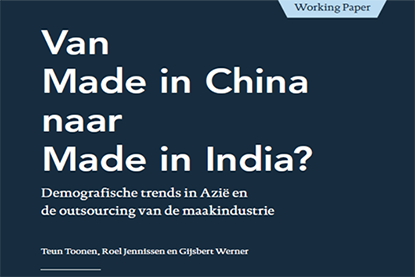Demographic developments abroad have an impact on the Dutch economy and trade
Major demographic changes abroad can affect trade flows to and from the Netherlands. This is shown by two Working Papers published today. These are the paper written by the WRR From Made in China to Made in India? Demographic trends in Asia and the outsourcing of manufacturing, and a study by the OECD entitled Assessing the impact of long-term global demographic changes on the Dutch economy and trade.
Both publications focus on how demographic development abroad can affect the Dutch economy and trade. The background studies were carried out within the WRR advisory trajectory Netherlands in an ageing world on the impact of an ageing and demographically shrinking world on the Netherlands. This advice is expected to be published during 2025.
Production chains
The WP 'From Made in China to Made in India?' describes how China emerged at breakneck speed as a production and export country from the 1990s onwards. A large part of the manufacturing industry in the Netherlands and other Western countries was outsourced there. This reduced prices for consumers and companies in the Netherlands and gave China a central role in production chains – many intermediate products for our industry also come from China. This development was largely possible because China had a rapidly growing and young working-age population. This paper shows that in the coming decades, ageing and population decline will create considerably less favourable circumstances for China to remain the ‘factory of the world’. Are there alternative countries that can make the goods that the Netherlands now imports from China? The uncertainties are considerable, but places that offer opportunities for this can be found in South-East Asia and in India. There, the coming decades will see a 'demographic dividend' – the working-age population is relatively large compared to the total population.
Trade flows
The second study was conducted by the OECD on behalf of the WRR. This research places these developments in a broader perspective. It looks not only at imports, but at all trade flows from and to the Netherlands. This is done using a quantitative model that maps how future changes in global demographics can lead to shifts in trade patterns from and to the Netherlands. The expectation is that imports to the Netherlands from China and Germany will decrease whilst imports from the United States and South-East Asia will become more important. This is related to the fact that whilst China and Germany are rapidly ageing and shrinking, the working-age population in the US and South-East Asia is maintaining its level or even growing. For exports from the Netherlands, the importance of Germany in particular may shrink in favour of the United States and emerging economies in Asia and Africa. These countries are becoming more important as markets because they are growing demographically. Such shifts in international value chains particularly affect sectors that are relatively labour-intensive. Some sectors of the Dutch economy are therefore more exposed to demographic changes in other countries than other forms of economic activity.
